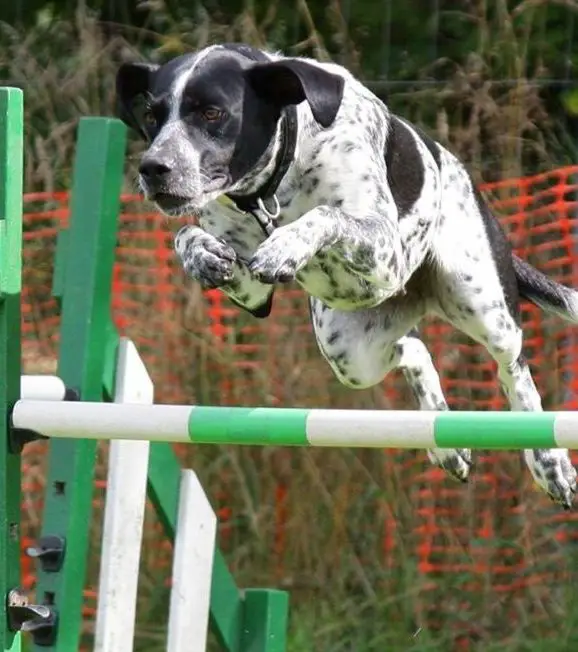I’m Leah Spaulding, and I am the proud owner of a rat terrier and a wonder mutt.
I have a huge background in pets–ranging from working in the holistic pet supply world, pet-sitting, pet training, and being the vice president of a pet nonprofit organization.
Today, I’m excited to bring you four (plus a bonus) of my favorite unique tricks to teach your dog with simple step-by-step instructions.
First, you’ll need to prepare a few things before teaching your dog these tricks. Ensuring you have training treats, a treat bag, and a distraction-free environment are a must.
For all of the tricks I’ve listed, you will need low-calorie training treats (or your dog’s kibble, if they’re food-motivated enough). A couple brands I recommend include: Cloud Star Tricky Trainers Chewy Grain Free Treats and Fruitables Crunchy Apple Bacon Biscuit Training Treats
I also suggest getting a treat bag to tote around so you can quickly reward the behavior you’re looking for.
You can find products designed for this very thing like this, but you can go as simple as keeping a ziplock bag with treats in your pocket.
Another thing you will need is your dog in a space that is free of distractions. Turn off the television, ask family members to leave the room, and pull curtains down on windows within your dog’s line of sight.
This place could be the center of your living room, your back yard, or a large bedroom with floor space. If there is furniture in the room, push them to the walls.
Once you’re ready with training treats, a handy treat bag, and a distraction-free space, you will be ready to tackle my teaching your furry friend some unique tricks to blow away your friends and to quench your dog’s desire for knowledge and fun.
As a tip, always use the same commands for the same trick. Consistency is crucial in training. Good luck!
4 Unique Tricks to Teach Your Dog!
1) Touch Your Nose
 What it Involves
What it Involves
This trick involves your dog brushing the back of their front paw on their nose. I consider this trick to be on the easy level.
You can teach it when your dog is sitting or laying down. Do what feels more natural for your dog!
What You’ll Need
Got post-it notes somewhere in the house? Perfect.
Along with the simple preparations I described above, you have all the necessary things needed to teach your dog to touch their nose.
Choosing the Command
Your first step is to decide on the command you would like to use.
I always suggest using short commands that are under three words. Some ideas include “nose,” “touch nose,” or my favorite–“who stinks?”
Stick it
Take a post-it nose and gently stick it to your dog’s muzzle. As soon as they touch their paw to it, say the command while simultaneously giving them a training treat.
Stick with it
I recommend practicing reinforcing the nose touch a few times a day for a couple of weeks.
When you feel like your dog has made the connection between touching their nose and getting the treat, you can take the post-it note out of the equation.
Once your dog is able to touch their nose without the sticky note, reward them with lots of praise and reinforce it for a few more days regularly so your dog really gets it.
Stick Out
Your dog will impress your loved ones, family, and friends with their cunning and endearing trick–and it’s sure to inspire some laughs if you couple it with a funny command!
You will love telling them the story of how you taught your dog to do such an endearing trick with a simple sticky note.
Quick Step by Step Recap:
- Pick a command
- Stick a post-it note to your dog’s nose and give them a command and treat when they touch their nose–practice this regularly for a couple of weeks.
- Try the command without the post-it note, and when they get it, reward them. Repeat this regularly until your dog gets it!
- Enjoy your dogs awesome trick!
2) Jump Through a Hoop
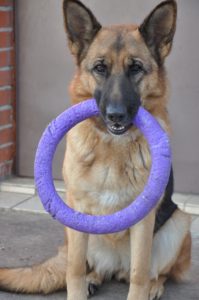 What it Involves
What it Involves
Teaching your dog how to jump through a hoop is a simple trick to understand. Your dog will be able to jump through a hula hoop you are holding.
Please ensure your dog is in shape enough to jump. Elderly dogs or dogs with joint issues may not be a good match for this trick.
What You’ll Need
You will need a large, open space (preferably outside) and a hula hoop.
Choosing the Command
For this trick, I recommend using “jump,” “jump in,” or “up.”
Jump In
Begin by holding the hula hoop on the ground. Encourage your dog with treats to approach the hula hoop.
Once your dog has warmed up to the hula hoop, use a treat to lead your dog through the hula hoop (they should be able to simply walk through the hoop as you will be holding it against the ground).
Every time your dog makes their way through the hoop, say the command you decided on, and immediately give your dog a treat.
Practice for a few times getting your dog comfortable with walking through the hula hoop.
Once you think your dog is comfortable walking through the hoop, start lifting the hoop a couple inches above the ground and see if your dog will go through it. If not, you will have to start at one inch above the ground.
Slowly work the height of the hoop up as you continue training over weeks.
Jumping for Joy
Once your dog has mastered the hoop jump, you can enjoy showing others your dog’s mastery of such a fun trick. It will also be good exercise for your dog!
Quick Step by Step Recap:
- Decide on the command you will use.
- Encourage your dog to get acquainted with the hula hoop using training treats
- Use a treat to lead your dog through the hula hoop. Practice this until your dog is comfortable walking through it.
- Start lifting the hula hoop off the ground a couple inches. Reward your dog for jumping through the hoop!
- Slowly work the height of the hoop up over weeks of training.
3) Skateboard
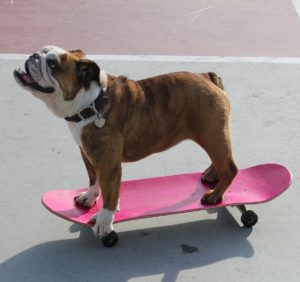 What it Involves
What it Involves
Teach your dog to push a skateboard with their front feet, propelling themselves forward using their back legs!
I would put this trick at a moderate training difficulty, as it requires your dog to know some other commands and a lot of time and patience to teach.
What You’ll Need
You’ll need training treats, a rope about three feet long, and a large open area (wood floors preferably, or smooth concrete if outside). You’ll also want a skateboard!
You’ll also need a dog that isn’t skiddish or nervous around objects like skateboards. Training is meant to be fun learning time for your dog.
I also caution against this trick if your dog is elderly or has joint issues. Better safe than sorry!
Choosing the Command
Before you begin, deciding on a command for this trick is important. It will be your dog’s cue to do a certain behavior.
Some commands you could consider for this one include “skate,” “skate board,” or “let’s roll.”
Give it a Spin
The first step is to use positive reinforcement to get your dog acquainted with the skateboard. Using a treat, guide your pup to approach the skateboard, and reward them for getting close to it.
The next step is to ensure the skateboard can’t move with your foot blocking the wheel (or something else to stop the skateboard from moving) and to lead your dog to place a foot or both feet on the skateboard.
Reward your dog each time they touch the skateboard with their paws. Repeat this for a few days.
Roll with It
Once your dog has established a connection between the skateboard and getting yummy treats, it’s time to move on to the next phase: moving the skateboard.
For this, you will attach the rope to the bottom of the skateboard by tying it or taping it. This time, when your dog puts their paws on the skateboard, you can gently tug the rope and pull the skateboard.
Reward your dog profusely with praise and training treats for keeping their paws on the skateboard and walking their back legs as you pull the skateboard.
When your dog is consistently “rolling with it,” remove the string and your dog should move the skateboard on their own.
Encourage them to push the skateboard longer and longer by walking backward with a treat in hand.
As always, I encourage you to repeat this trick frequently to give your pup enough practice time to retain what they’ve learned.
Let the Good Times Roll
Those you love will be delighted to see your dog skateboarding! There is nothing cooler than seeing a dog skating on a skateboard. Who knows, maybe your dog will be the next internet sensation?
Quick Step by Step Recap:
- Choose the command you would like for this trick
- Get the dog acquainted with the skateboard by using positive reinforcement
- Ensuring the skateboard won’t move with your foot, lead the dog to place their front paws on the skateboard with treats and reward it. Repeat until your dog is comfortable. Use the command!
- Attach a rope to the skateboard and try leading your dog to step on the skateboard. Pull very gently, trying to get the dog to walk their back legs a bit. When they succeed in that, use your command and training treats! Continue working with your dog on this for as long as it takes for them to get it, usually a few weeks.
- Try the command without the rope, and see if your dog pushes the skateboard along on their own! Reinforce with training treats and lots of praise!
4) Say “Mama”
 What it Involves
What it Involves
When people learn that my rat terrier can say “mama” on command, they always ask me how I was able to teach him how to do it.
I will say that if your dog is not verbal, this may not be a trick you will be able to teach them. My dog is very verbal when food is involved, and if your dog is too, I can guide you through how I was able to teach my dog.
Some dog breeds that have a natural affinity to be verbal include huskies, german shepherds, hound dogs, and border collies.
Because this trick involves a long period of patience and is very hard to teach, I am rating it hard on the training difficulty scale.
What You’ll Need
In my dog’s case, I needed food that my dog was really excited about (like boiled chicken)–because it made him “yodel” with excitement. If you notice that your dog is verbal about something else–like a toy, use that.
Speak Up!
When you’ve found something that really gets your dog talking–listen to their natural voice. Are there any noises they make that sound like words? Sometimes dogs will sound like they’re saying “rebel” or “I love you.”
Once you’ve found a “word” you want to encourage, use the item or food that causes your pet to verbalize, and ask them to say the word–my command is “say Mama”.
Then, only give your dog treats when they use that specific combination of sounds.
In my dogs case, he would make a noise like “mla mla”–and eventually through months of work, it started to sound like “mama” as I got more picky on what noise he had to make to get the treat.
You Said it!
There’s something so rewarding about having a dog that can talk back to you, even a little. Friends and family will be so impressed that you have a dog that can say an english word!
It melts my heart when my dog says “mama” when I don’t even ask him to. If I have a treat in my hand, or he wants something, he knows I’ll listen.
You can check out the video of him saying “mama” below!
Quick Step by Step Recap:
- Find something that makes your dog verbal–whether it’s a toy or food.
- Decide what word you would like your dog to say. Try finding a word that sounds like the noises they already make, and then use the command, “say (word).”
- Reinforce the specific sound you are looking for, getting pickier as you go along to refine the word. Reinforce with the command and treats!
- Practice, practice, practice! This could take months to perfect.
BONUS: Create Your Own Unique Dog Trick!
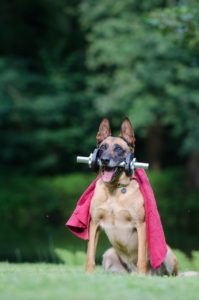 All dogs have their own unique quirks and behavior, which you can use to create a unique trick just for your dog.
All dogs have their own unique quirks and behavior, which you can use to create a unique trick just for your dog.
Does your dog tap their feet like a tap-dancer when they are excited? Or does your dog “yodel” when that one song comes on the radio? Bounce up and down when they’re excited? Chase their tail?
Carry training treats with you at home and reward your dog when they present the behavior as you call out the command–just as described with the other tricks.
Before you know it, you’ll have a trick unique to your pup, with a command of your choice! I encourage you to get creative with the command and to have fun with it, but to keep it brief. Commands should be one or two words.
Quick Step by Step Recap:
- Find a behavior your dog wants to do that you want to turn into a trick.
- Decide on the command you want to use–have fun with it!
- Reinforce the behavior using the command and training treats.
- Practice makes perfect!
Are You Having Trouble Training Your Dog?
One of the best ways is to learn by seeing, then doing. Therefore, I recommend Brain Training for Dogs
Brain Training for Dogs has video courses with in-depth instructions on how to train your dog using force-free positive reinforcement coupled with scientifically-proven effective ways to train your pup.
There’s even step-by-step instructions on how to teach your dog how to play the piano (I’ve seen a video–it’s adorable!)
The course covers a vast amount of dog training elements, from behaviour, to fun tricks that you can teach your dog!
We’ve had the course reviewed by a certified dog trainer, which you can check out here!
Final Thoughts
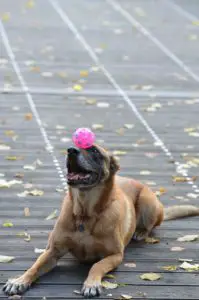 I hope you enjoyed my list of five unique tricks to teach your dog.
I hope you enjoyed my list of five unique tricks to teach your dog.
Teaching your dog new tricks can be a wonderful bonding experience for you and your pet, and I hope I’ve opened new possibilities for those special moments.
From teaching your dog how to touch their nose, say a word or phrase, ride a skateboard, jump through a hoop, or teaching your dog a trick of your own invention, I hope you have a blast teaching your dog.
I love teaching my dogs new things, and I truly believe that they enjoy the challenge and learning, and I know I enjoy the bonding one-on-one time I spend with my furry friends.
My rat terrier knows sit, stay, shake hands, watch-out, roll-over, dance, speak, say “mama,” sit pretty, and lay down.
My mutt knows how to sit and shake hands (which took forever for him to learn). Obviously, dogs can have huge differences in trainability.
Teaching your dog a new trick involves good timing–there will be a lot of time you spend waiting for your dog to do the right thing so that you can immediately reward it.
You will also need patience to teach your dogs new tricks. You will need patience as your dog learns and as you repeat actions with them over and over.
Happy training!
